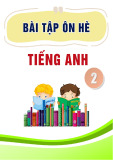
TNU Journal of Science and Technology
229(03): 243 - 250
http://jst.tnu.edu.vn 243 Email: jst@tnu.edu.vn
CONTRASTIVE ANALYSIS OF PRACTICALITY OF USING MOTHER TONGUE
AND ENGLISH-ONLY POLICY IN CLASS TO TEACH LEGAL ENGLISH
Ba Minh Tu1, Vu Van Tuan2*
1People’s Security Academy
2Hanoi Law University
ARTICLE INFO
ABSTRACT
Received:
22/02/2024
The quandary of the choice between the use of English-only policy or
mother tongue in learning and teaching English for Specific Purposes has
been ongoing for the past few years at the tertiary level. This study aims
to investigate the effectiveness and practicality of implementing the two
teaching and learning approaches. The quasi-experimental study was
conducted with 56 students in two classes with different pedagogical
practices in longitudinal tests during the first term of the academic year
2023-2024. The findings demonstrate that the distinction line is not
significant; however, the mother tongue class illustrates a little bit higher
in their test results, which indicates that the role of the mother tongue
class in teaching English for specific purposes, especially legal English is
still essential to some extents. Besides, the students pursuing a dual-
degree program gain better achievement in learning legal English as their
understanding legal English is somehow supported by the knowledge
from their dual-degree program. This empirical study gives a deep insight
of the appropriate choice of methodological practices in legal English
teaching and learning.
Revised:
22/3/2024
Published:
22/3/2024
KEYWORDS
Practicality
Legal English
Mother tongue
English-only policy
Pedagogical practices
PHÂN TÍCH SO SÁNH TÍNH THỰC TIỄN CỦA VIỆC CHO PHÉP DÙNG
NGÔN NGỮ THỨ NHẤT VÀ CHÍNH SÁCH CHỈ SỬ DỤNG TIẾNG ANH
TRONG GIẢNG DẠY TIẾNG ANH PHÁP LÝ
Bá Minh Tú1, Vũ Văn Tuấn2*
1Học viện An ninh Nhân dân
2Trường Đại học Luật Hà Nội
THÔNG TIN BÀI BÁO
TÓM TẮT
Ngày nhận bài:
22/02/2024
Sự khó khăn trong việc lựa chọn chỉ sử dụng tiếng Anh hay tiếng mẹ đẻ
trong việc học và dạy tiếng Anh chuyên ngành đã diễn ra trong vài năm
qua ở cấp độ đại học. Nghiên cứu này nhằm mục đích khảo sát tính hiệu
quả và tính thực tiễn của việc triển khai hai phương pháp dạy và học nói
trên. Nghiên cứu bán thực nghiệm được thực hiện với 56 sinh viên ở hai
lớp và áp dụng các phương pháp sư phạm khác nhau trong các bài kiểm tra
từng giai đoạn trong học kỳ 1, năm học 2023-2024. Kết quả của nghiên
cứu đã chứng minh rằng sự khác biệt về kết quả học tập giữa hai nhóm lớp
học thực nghiệm không đáng kể. Tuy nhiên, kết quả bài kiểm tra của lớp
có sử dụng ngôn ngữ tiếng mẹ đẻ cao hơn một chút, điều này cho thấy vai
trò của tiếng mẹ đẻ trong việc dạy tiếng Anh chuyên ngành, cụ thể là tiếng
Anh pháp lý ở một mức độ nào đó vẫn rất cần thiết. Ngoài ra, sinh viên
đang theo học chương trình song bằng đạt được thành tích tốt hơn trong
việc học tiếng Anh pháp lý vì khả năng hiểu tiếng Anh pháp lý của sinh
viên phần nào được hỗ trợ bởi kiến thức từ chương trình bằng kép.
Nghiên cứu thực nghiệm này mang đến cái nhìn sâu sắc về sự lựa chọn
phù hợp các phương pháp thực tiễn trong dạy và học tiếng Anh pháp lý.
Ngày hoàn thiện:
22/3/2024
Ngày đăng:
22/3/2024
TỪ KHÓA
Tính thực tiễn
Tiếng Anh pháp lý
Ngôn ngữ thứ nhất
Chính sách chỉ sử dụng tiếng
Anh
Thực tiễn sư phạm
DOI: https://doi.org/10.34238/tnu-jst.9745
* Corresponding author. Email: tuanvv@hlu.edu.vn

TNU Journal of Science and Technology
229(03): 243 - 250
http://jst.tnu.edu.vn 244 Email: jst@tnu.edu.vn
1. Introduction
Using the mother tongue in teaching English under which circumstance refers to the fact that
when a school or educational institution integrates the language learners’ mother tongue (or so-
named first language) into English lessons. There has been an ongoing debate about the choice of
whether the mother tongue should be used in teaching English, especially English for Specific
Purposes (ESP), or whether an English-only policy should be strictly implemented in ESP classes
to create a challenging English language zone. Advocates of using the mother tongue [1] - [3]
would claim that it is normal for language learners to use translation as it is a natural
phenomenon when acquiring another language. They further argue that even if one student goes
overseas for his/her language acquisition, it is useful for him/her to either translate everything
into their mother tongue for a few months or take advantage of using a bilingual dictionary to
look up a knowledge base of vocabulary. Many studies [3] - [5] have proven that code-switching
and translation in learning a new language take place instinctively for all language learners, so
first language (L1) is regarded as an important resource in second language (L2) learning.
Teachers should adopt this innate tendency rather than against it. Some researchers acknowledge
that learning another language possibly adds richness to students’ lives, and it causes little harm to
devalue learners’ language and culture. When students are allowed to use L1 in ESP classes, they
would develop the sense of acquiring another language to experience a positive setting. They feel
efficient to have access to a valuable resource assisting them in difficulty learning a new language
and they also do not have a terribly guilty conscience about losing their faces in case of not
completing one task successfully. Given a situation where students are not allowed to use L1 in
English classes, they even receive punishments for breaking this rule. Elena [6, p. 37] reveals that
students do not speak their mother tongue explicitly but employ their L1 quietly and feel a sense
of shame if they are given some forms of punishments for their utilizing their L1 during the
acquisition of L2. In one study conducted by Kani and Igsen [7], the researchers state that L1
helps strengthen the relationship between teachers and students under the teachers’ perspectives
by sharing what learners are confronted with in terms of learning ESP, especially legal English.
Besides, communicating with learners in their first language can be more efficient and make time
for more useful activities. Teaching ESP, especially legal English has its own distinctive
characteristics, which causes many challenges for language learners to understand even native
speakers of English. It seems to be very frustrating when instructions for one activity in English are
complicated, whereas students show difficulties comprehending the English explanation. Under this
circumstance, one student appointed to translate the task requirements in their L1 language would
save time for other activities and prevent a lot of frustration for both teachers and students.
Although using the mother tongue would have a beneficial effect on legal English language
teaching and learning, translation could result in the development of an excessive dependency on
the students’ L1 by both teachers and students [8]. As a result, students lose their confidence in
their ability to communicate in the ESP field, they may believe that the only way to understand
legal English is to master language translation. Or they are likely to use their mother tongue during
legal English lessons even though they are perfectly able to express their ideas in English. This
habitual reaction of using the mother tongue in learning legal English might discourage the use of
English in class. They feel at ease translating from legal English to their first language and then
converting their ideas from their mother tongue to English. This process is greatly dependent on the
students’ L1 language. In other words, the translated dependency of students’ L1 language in
learning L2 one and vice versa would significantly reduce students’ opportunities to practice legal
English, and students also do not really recognize the importance of using English in classroom
activities to enhance their English competence [9] - [12]. Another concern about the frequent
translation is blamed for the problem of oversimplification, which is due to the fact that many
cultural and linguistic nuances cannot be directly translated, especially legal English. As clearly

TNU Journal of Science and Technology
229(03): 243 - 250
http://jst.tnu.edu.vn 245 Email: jst@tnu.edu.vn
stated in Vu and Le [13], some typical characteristics of legal English have been identified such as
peculiarities of legal English, legal French terms and Latinisms, archaic diction of legal English,
modality, frequent use of doublets and triplets, and technical terms. Research has shown that there
are many non-equivalencies between two language systems, which would make no sense at all if
being translated directly from the source language to the target language and the other way around.
In order to evaluate the effects of using L1 in legal English-language learning for the purpose of
how to maximize the benefits and minimize the repercussions, this longitudinal, quasi-experimental
study was conducted during the first-term of the 2023-2024 academic year with 56 legal English
major students at Hanoi Law University (HLU) to shed light on the following questions:
1. How effective is it to implement the English-only policy in legal English language learning
classes?
2. Which method of teaching practicality would be more efficient - the English-only policy or
mother tongue approach?
This quasi-experimental study was backed up by two classes – one class with 28 participants
was treated as an experimental group with the English only policy in class and the other with 28
respondents was classified as a control group with mother tongue allowance. The collected data of the
two groups were carefully scrutinized and analyzed to reflect the differences between two classes.
2. Materials and Methods
2.1. Research design
This quasi-experimental research was conducted in a method of longitudinal studies,
specifically pre-test, first post-test, and second post-test applied for both assigned classes to
evaluate whether students demonstrate the effectiveness of their learning legal English
performance in pursuance with teaching and learning approaches. For the purpose of legal
English, the participants experienced the same three periodic formats of Test of Legal English
Skills (TOLES) – Foundation level, which assessed reading and writing skills with a focus on
legal vocabulary in context. The test results would be used to prove the practicality of teachers’
methodological implementation. Based on these findings, the researchers arrived at some
conclusions and implications to take legal English teaching approaches into consideration.
2.2. Participants
The two classes were chosen purposefully when legal English major students registered the
basic legal English No.2. during the first term of the 2023-2024 academic year at HLU. The
control group consisted of 28 legal English major students, who underwent the implementation of
the English-only policy or so-called monolingual class. In particular, there were 23 female
students, accounting for 82.1%, and 5 male ones, representing 17.9%. Similarly, 16 students
(57.1%) in this group stated that they were doing dual-degree programs – majoring in legal
English and laws while 12 participants (42.9%) informed that they had not clearly planned to take
other programs at present. For the quasi-experimental class, they also included 28 students in
which the majority of the sample was 21 female students, making up 75% and the rest was 7
male participants, constituting 25%. Meanwhile, the majority of the students (n = 19; same as
67.9%) in this class claimed that they had not taken second-degree diplomas currently, and 9
legal English students (32.1%) acknowledged that they were pursuing dual-degree programs. All
the legal English major students had already studied basic legal English No.1 in 3 credits.
2.3. Research instrument and data collection
The research utilized three researchers’ constructed tests which consisted of 80 items
according to the TOLES Foundation level, which assessed reading and writing skills with a focus
on legal vocabulary in context. Regarding listening and speaking skills, they would not be
concentrated on the basics of legal English. Each test last 90 minutes and was scored from a

TNU Journal of Science and Technology
229(03): 243 - 250
http://jst.tnu.edu.vn 246 Email: jst@tnu.edu.vn
possible total of 100 points. The pre-test was given to both classes at the beginning of the basic
legal subject No.2, which included in 3 credits. When two credits were over, the first post-test
was administered for the purpose of checking their progress. Finally, the second post-test was
carried out at the end of the basic legal subject No.1. Then the researchers used one statistics
computing application, namely IBM SPSS v.26 to manipulate the test results.
2.4. Data analysis
Descriptive statistics was applied to analyze the gender and identify whether legal English major
students followed the dual-degree programs or not. Pair sample T test and MANCOVA were
utilized to assess the progress and disparities between two groups over three longitudinal tests.
3. Results and Discussion
Table 1 displays the test of sphericity for the purpose of finding out whether the error
covariance matrix of the orthonormalized transformed dependent variables is proportional to an
identity matrix. Since the p-value (Sig. = 0.001) is less than α = 0.005, which denotes the fact that
the covariances are equal; that is, the learning performance of the two classes is progressive so
data from a multivariate perspective should be reviewed as in the Table 1.
Table 1. Descriptive statistics of hypothesis tests
Mauchly's Test of Sphericitya
Within Subjects Effect
Mauchly's W
Approx.
Chi-
Square
df
Sig.
Epsilonb
Greenhouse-
Geisser
Huynh-
Feldt
Lower-
bound
English-only Policy Class
& Mother Tongue Class
0.771
13.795
2
0.001
0.814
0.851
0.500
Tests the null hypothesis that the error covariance matrix of the orthonormalized transformed dependent
variables is proportional to an identity matrix a.
a. Design: Intercept + Methodological implementation
Within Subjects Design: English-only Policy Class & Mother Tongue Class
b. May be used to adjust the degrees of freedom for the averaged tests of significance. Corrected tests are
displayed in the Tests of Within-Subjects Effects table.
Table 2 summarizes the results of the longitudinal tests of the two classes. The outcomes
showed that although the students in the English-only policy class had got better results in the
same pre-test and gained the accumulative achievement in their learning legal English, they had
not obtained their scores as well as those in the mother tongue class in the first and second post-
tests. This finding indicates that the students in the English-only policy class have undergone
some problems with their understanding of the knowledge of legal English. Those who are in the
mother tongue class are allowed to use the mother tongue to exchange whenever they come
across the obstacles of legal English challenges. This finding is in line with another recent study
[13], which investigated the perceptions of legal English major students and concluded that their
respondents also encountered some problems with the comprehension of legal English.
Table 2. Descriptive statistics of longitudinal tests
Methodological implementation
Mean
Std. Deviation
N
Pre-test
English-only policy class
6.12
0.368
28
Mother tongue class
5.84
0.376
28
Total
5.98
0.394
56
Post-test 1
English-only policy class
6.64
0.275
28
Mother tongue class
6.72
0.223
28
Total
6.68
0.252
56
Post-test 2
English-only policy class
6.91
0.319
28
Mother tongue class
7.26
0.290
28
Total
7.09
0.349
56

TNU Journal of Science and Technology
229(03): 243 - 250
http://jst.tnu.edu.vn 247 Email: jst@tnu.edu.vn
Table 3 reveals the effectiveness of implementing the English-only policy class and mother
tongue class. As glimpsed from the p-value (Sig. = 0.00), it is concluded that the null hypothesis
of the assumption of homogeneity of variance differences or the assumption of ferocity within
these classes are acknowledged with some differences in the values. These differences signify
that the changes between the two classes are not the same. This is even clearer reflected in terms
of comparing two classes with the pedagogical practices with the assumption that there is no
similarity between the methodological approaches the participants experienced in each class. The
p-value (Sig. = 0.00) rejects this presumption and proves that these teaching methods still enable
the students to get improved in their learning process but not the same results by looking at the
value column. This statement is somehow found similar to the previous studies [2], [9], [6].
Table 3. Descriptive statistics of multivariate tests within subjects design of
English-only policy class and mother tongue class
Multivariate Testsa
Effect
Value
F
Hypothesis df
Error df
Sig.
Partial Eta Squared
English-only policy class
& mother tongue class
Pillai's Trace
0.85
145.06b
2.00
53.00
0.00
0.85
Wilks' Lambda
0.15
145.06b
2.00
53.00
0.00
0.85
Hotelling's Trace
5.47
145.06b
2.00
53.00
0.00
0.85
Roy's Largest Root
5.4
145.06b
2.00
53.00
0.00
0.85
English-only policy class
& mother tongue class
* Methodological
implementation
Pillai's Trace
0.31
11.77b
2.00
53.00
0.00
0.31
Wilks' Lambda
0.69
11.77b
2.00
53.00
0.00
0.31
Hotelling's Trace
0.44
11.77b
2.00
53.00
0.00
0.31
Roy's Largest Root
0.44
11.77b
2.00
53.00
0.00
0.31
a. Design: Intercept + Methodological implementation
Within Subjects Design: English-only Policy Class & Mother Tongue Class
b. Exact statistic
Similarly, Table 4 illustrates the effects of the three tests of the English-only policy class and
mother tongue class regarding evaluating whether there is homogeneity of the outputs between the
practices of different methodological language teaching. The p-value (Sig. = 0.00) indicates that all
values in the Sig. values are less than 0.05, which acknowledges that the hypothesis of no similarity
between these two classes is accepted. Additionally, the degree of freedom (df) in the Error
regarding the two classes and the implementation of teaching methods are not quite close, which
means that the perspectives of the respondents are not quite similar. Besides, the mean square also
bears the same situation; that is, the participants had different viewpoints about the methodological
implementation of the teachers concerning legal English language teaching and learning. This
finding is somehow similar to one recent study [2], which points out the dissimilar ideas about the
implementation of the mother tongue in ESP language learning and teaching in general.
Table 4. Test of Within-subjects Effects
Source
Type III Sum
of Squares
df
Mean
Square
F
Sig.
Partial Eta
Squared
English-only policy class
& mother tongue class
Sphericity Assumed
35.24
2
17.62
211.27
0.00
0.80
Greenhouse-Geisser
35.24
1.63
21.66
211.27
0.00
0.80
Huynh-Feldt
35.24
1.70
20.71
211.27
0.00
0.80
Lower-bound
35.24
1.00
35.24
211.27
0.00
0.80
English-only policy class &
mother tongue class *
Methodological implementation
Sphericity Assumed
2.76
2
1.38
16.52
0.00
0.23
Greenhouse-Geisser
2.76
1.63
1.69
16.52
0.00
0.23
Huynh-Feldt
2.76
1.70
1.62
16.52
0.00
0.23
Lower-bound
2.76
1.00
2.76
16.52
0.00
0.23
Error (English-only policy
class & mother tongue class *
Methodological implementation)
Sphericity Assumed
9.01
108
0.08
Greenhouse-Geisser
9.01
87.87
0.10
Huynh-Feldt
9.01
91.89
0.10
Lower-bound
9.01
54.00
0.17





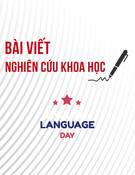
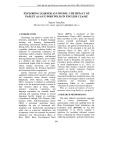
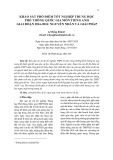
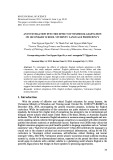
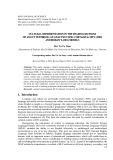
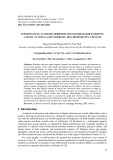
![Tài liệu Từ vựng tiếng Anh Trung cấp [mới nhất]](https://cdn.tailieu.vn/images/document/thumbnail/2025/20250913/nguyentuan250421@gmail.com/135x160/99491757910839.jpg)
![Tài liệu Từ vựng Tiếng Anh theo chủ đề [mới nhất]](https://cdn.tailieu.vn/images/document/thumbnail/2025/20250913/namdhuet@gmail.com/135x160/83251757753810.jpg)


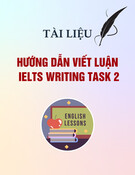
![Tài liệu Từ vựng tiếng Anh cho bé [chuẩn nhất/mới nhất]](https://cdn.tailieu.vn/images/document/thumbnail/2025/20250731/huadaithesang2509@gmail.com/135x160/18631754013896.jpg)





